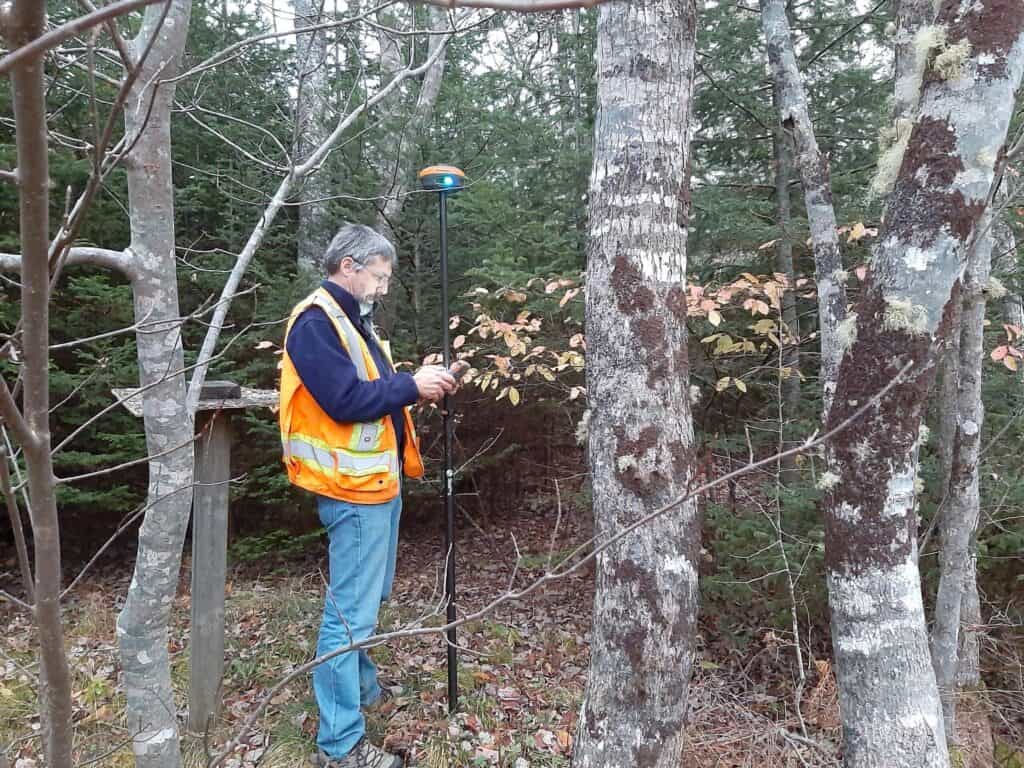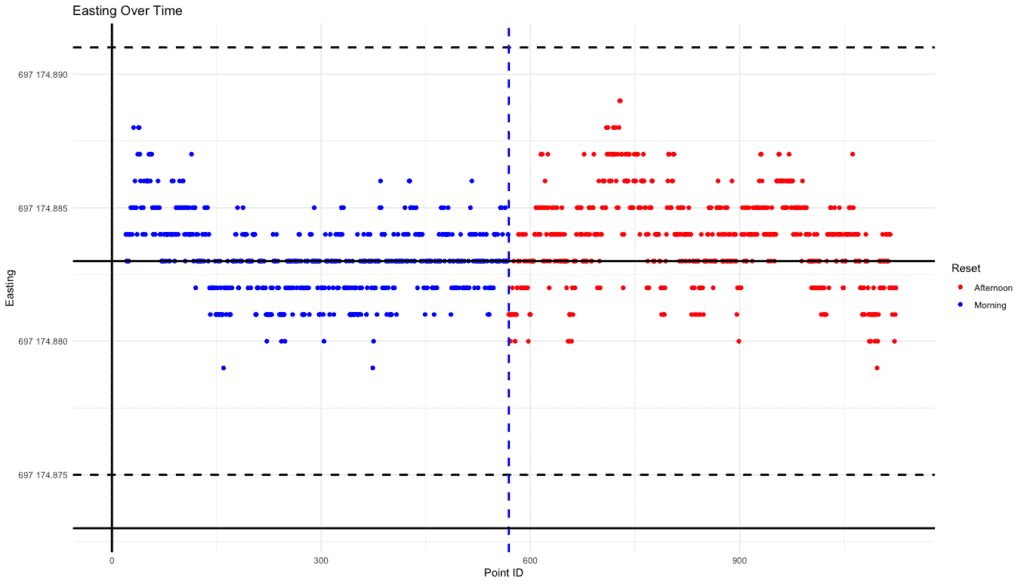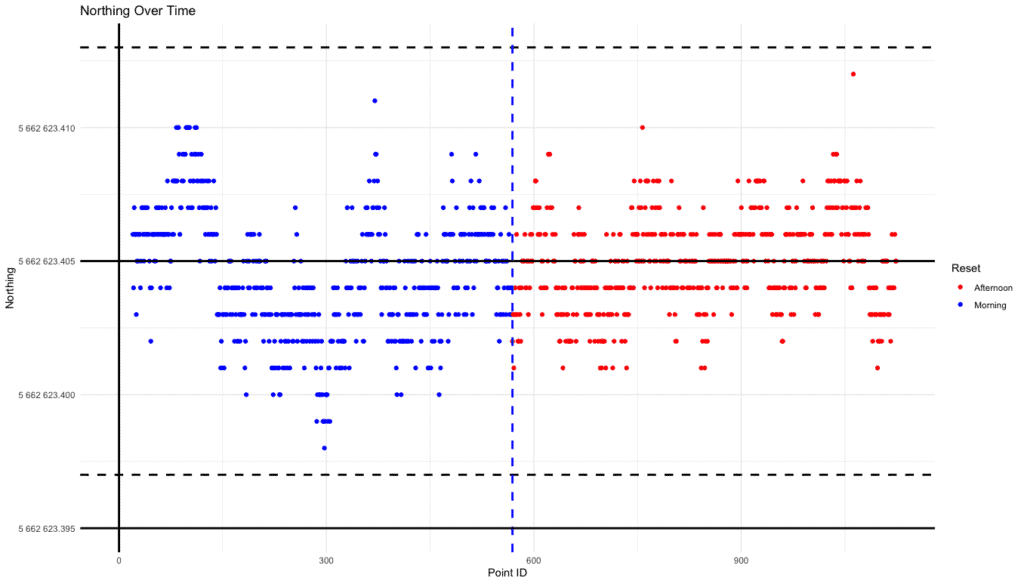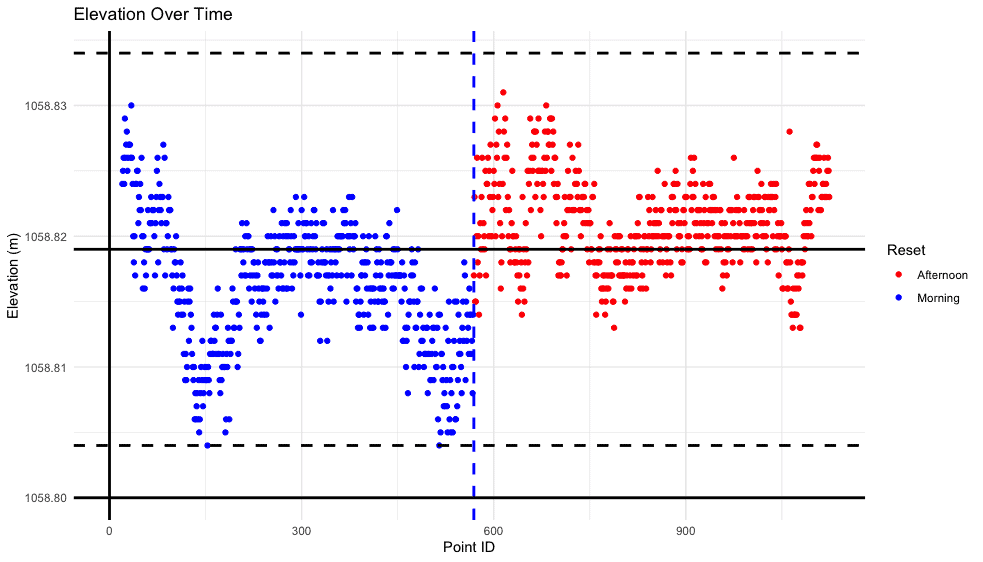
Over the years, we’ve sold hundreds of Hemisphere S631 systems to surveyors across Canada, the US, and even around the world. And there is one universal theme they always ask about: How reliable and repeatable this equipment is. Without being able to rely on their equipment, surveyors cannot properly do their job.
Because let’s be real: when you’re doing a survey and putting your name on a survey plan, you’re taking on a ton of responsibility and liability. If you can’t trust your equipment or the results it’s giving you it isn’t worth anything. That’s why having tools you can rely on is critical.
In this post, we’re going to dive into the reliability of our RTK (Real-Time Kinematic) equipment, address some common misconceptions, respond to critiques we’ve received, and show you the results of tests we’ve done. By the end, you’ll have a clearer picture of why the S631 is a tool you can trust in the field. (If you don’t want to read, check out our video where we talk about this topic!)
What’s the Deal with RTK Reliability?
Tackling Feedback and Misconceptions
Why the S631 Stands Out from Other Receivers
How We Set Up Our Repeatability Test
Where We Are Headed with Our Videos and Tests
In our videos, we’ve talked a lot about things like “time to fix”—basically, how fast a receiver can lock onto a fixed solution. But a lot of you have pointed out that speed alone isn’t enough. What really matters is the accuracy and consistency of those results.
Trimble R12: https://youtu.be/klqXmSGW-XE
Trimble R10: https://youtu.be/1RPeam1zcls
Trimble R8: https://youtu.be/ynlhbUIXwDw?feature=shared
Trimble SPS986: https://youtu.be/Zn9wC_ZEx3w
Spectra SP80: https://youtu.be/wMNjdzNPxyE
Leica GS18: https://youtu.be/v4BLjv11Thk
Topcon Hiper VR / Sokkia GRX3: https://youtu.be/BffxsmBYASQ
Carlson BRx5: https://youtu.be/JGauG5gSzck?feature=shared
So today, we’re taking a closer look at reliability and how reliable the calculated position is. To do this, I want to first clear up some misconceptions, explain how we are going to conduct our tests and then show you some results of our tests.
I get a lot of comments on our YouTube videos, especially our Time-to-Fix videos. For our repeatability test, I wanted to respond to some of these comments and make sure we show you all the results you want to see.

Why Not Compare RTK with a Total Station?
I think this a great comment, comparing RTK results without verifying them against a high-precision validated coordinate is difficult. The suggestion of doing multiple shots and checking the shot-to-shot coordinate variation is a great way to check how valid the points. That being said, there are a couple of things I am going to change for my tests.
1. Time Is a Factor: Unfortunately, I am but one man performing these tests. Videos like this one can be massive time commitments, and even performing one shot at one location can take me an entire day. This is before factoring in tying into and establishing a coordinate with a total station in a location that will challenge the receiver.
2. Tech Differences: Comparing RTK and total station data can be a bit tricky. They use completely different technologies, and there are variables—like operator influence—that can make direct comparisons misleading. As well, with RTK we are looking at single point error. If the position remains stable after resets and does not display any changing bias as satellite geometry changes, I am going to assume that the position is reliable. For this reason, I am not going to compare the coordinates directly to a total station shot. Instead, I am going to assume that if the coordinates are unreliable in a location, we would see a changing bias in the coordinates over the course of the day.
Still, Artymann made some great suggestions in his comment. I think we can definitely apply multiple of these suggestions to our test.

Test in More Real World Conditions
Nikoeur also made a great suggestion: instead of just taking single-point shots back-to-back, we should test at different times, on different days, and in varied conditions. This would give a better picture of the system’s repeatability. I couldn’t agree more, and that’s exactly what I did for this test:

Does Software Matter?
Another user, JRR2286, raised a concern that the data collection software could affect RTK performance. Here’s the deal:
The software you’re using—whether it’s Carlson’s SurvPC/CE, MicroSurvey’s FieldGenius, or Trimble’s Access—doesn’t actually impact how the RTK engine calculates positions. It’s just a graphical interface showing the data your receiver is producing. An RTK receiver calculates its position entirely onboard the receiver. The software then takes the computed Latitude, Longitude and Elevation and translates it to the relevant coordinate system. You can read more about GNSS receivers actually work here: How Does a GNSS Receiver Work?.
For our tests, we always set up the systems with consistent configurations to ensure fairness. I haven’t in the past shown this on video, as we try to keep them more interesting to watch. In the future we will see what we can do about including more background information.
Before we jump into the test results, let’s talk about what makes the S631 able to outperform other receivers and guarantee your repeatability. The secret is in Hemisphere’s Athena RTK engine and the SureFix Fix mode.
The Athena RTK engine is able to take data from all major constellations; GPS, Glonass, Galileo, and BeiDou. And unlike many other RTK receivers, the S631 is able to obtain a fix initially on any constellation. A lot of other manufacturers first have to fix on the GPS constellation before bringing in data from other constellations. The S631 is able to use the constellation that is providing the best data, helping it fix faster.
SureFix is designed to ensure that your receiver does not obtain a bad fix.
Here’s how it works:
1. The S631 uses two independent RTK engines to process satellite data at the same time.
2. If the two engines don’t agree on the position, the system won’t report a fixed solution.
This dual-check system is incredibly robust. The chances of both engines getting it wrong at the same time? Practically zero. You’re more likely to win the lottery or get struck by lightning than to get a bad fix in open-sky conditions.

For our repeatability test, we wanted to make sure everything was as fair and transparent as possible, while incorporating as many as your suggestions as possible. Here’s what we did:
1. Mounted the Receiver on a Fixed Pole
This eliminated any chance of human influence or movement affecting the position. There should be no tripod slipping or sinking over the course of our test.
2. Connected to a Base Station
We used our StormCaster base station and the latest RTCM3 MSM signals, with all constellations enabled. This ensures the receiver is getting the best available data and is what Hemisphere recommends to be used. Our baseline was under 100 ft, which should eliminate any effect of the distance from the reference station influencing our accuracy.
3. Recorded Data Every 30 Seconds
In order to see if our position changed at all, we recorded data for a one second epoch every thirty seconds, and did not average our position. In the field, we typically recommend taking a longer average on legal coordinates to ensure the best accuracy. However, a one second position should give the best indication of the true position and performance of the receiver.
Thanks to Mark for pointing this out to me, I spoke a little too ambiguously in the video.
4. Performed a Factory Reset on the Receiver
In order to ensure that the receiver was not performing any tricks or had a phantom fix, we performed a factory reset. This forces the receiver to recalculate its positions from scratch, ensuring no reliance on previous data to calculate its position.
5. Recorded Data Throughout the Day
In order to ensure that the satellite geometry changed, we recorded positions over the course of an entire day. In our test for this article, we recorded positions from ~730 to 1640. This should expose any hidden bad fixes that may result from poor satellite geometry.
6. Receiver Position
For our initial test, we took shots in an open sky environment. This should allow us to establish a stable baseline for our future tests and something we can compare difficult conditions to.
The results were exactly what we expected a very stable and repeatable position well within manufacturer specifications. This shouldn’t be surprising, as for this test we were in an open sky environment. Any modern 7th generation receiver should easily be able to obtain repeatable positions in this kind of environment.
In the below graphs, the solid black line denoted the median position, the dashed black line is for the expected standard error and the dashed blue line notes the time of the reset.
Horizontal Positioning (Easting and Northing)
Easting: The median position was 697,174.875 meters, with a deviation of just ±2 millimeters over the entire day. We had zero shots outside of the +/- 8mm RTK specification.

Northing: The median position was 566,623.405 meters, also with a deviation of ±2 millimeters. Again, we saw no points outside the +/- 8 mm expected error ellipse.

Even after the factory reset, the system maintained its consistency. That’s a big deal—it shows the S631’s results aren’t just accurate but repeatable over the course of ~9 hours.
Vertical Positioning (Elevation)
As expected, the vertical results weren’t quite as tight as the horizontal ones (RTK systems typically have 2x the amount of error in the vertical compared to the horizontal). The S631 stayed within ±15 millimeters, well within manufacturer specs. While there was a bit more variability, it was still impressively consistent, with 0 points outside of the expected error ellipse.

We’re not stopping here. While this test focused on open-sky conditions, we’ve got more planned. Next up:
If you have any ideas on what we could do to improve these tests, or what you would like to see from use, send me an email at [email protected] or simply leave a comment on one of our YouTube videos. I always do my best to respond to every comment we receive.
When it comes to surveying, trust is everything. You need to trust your skills, your data, and, most importantly, your equipment. The S631 delivers on that trust. With its SureFix RTK engine and proven repeatability, this system is built to give you confidence in the field.
If you have questions, feedback, or ideas for future tests, drop us a comment. We’re here to help and to make sure you have all the information you need to succeed.
RTK GPS repeatability is determined by its ability to consistently provide accurate, stable positions over time and under varying conditions. Features like the Hemisphere S631’s SureFix RTK engine enhance this reliability by using two independent algorithms to verify every position, ensuring bad fixes are avoided.
No, the software is just an interface displaying the data calculated by the RTK receiver. The calculations are performed entirely onboard the receiver, independent of the field software used.
For the initial tests, the S631 was evaluated in an open-sky environment to establish a stable baseline. Data was collected throughout the day, with factory resets forcing fresh calculations to ensure consistent performance under changing satellite geometry.
RTK GPS repeatability is determined by its ability to consistently provide accurate, stable positions over time and under varying conditions. Features like the Hemisphere S631’s SureFix RTK engine enhance this reliability by using two independent algorithms to verify every position, ensuring bad fixes are avoided.
Bench Mark Equipment & Supplies is your team to trust with all your surveying equipment. We have been providing high-quality surveying equipment to land surveyors, engineers, construction, airborne and resource professionals since 2002. This helps establish ourselves as the go-to team in Calgary, Canada, and the USA. Plus, we provide a wide selection of equipment, including global navigation satellite systems, RTK GPS equipment, GNSS receivers, and more. We strive to provide the highest level of customer care and service for everyone. To speak to one of our team today, call us at +1 (888) 286-3204 or email us at [email protected]
